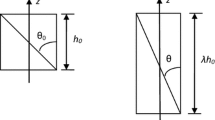Abstract
The experiments and their interpretation presented here examine the interrelation between the crystalline and amorphous components of oriented polymers. In particular, oriented low-density polyethylene was examined by low-angle X-ray scattering in successive stages of heat relaxation, both at room temperature and at the temperature of the heat-treatment. These experiments were supplemented by measurements of dimensional changes occurring during annealing and those produced by swelling. The effect of redrawing from various stages of annealing and that of oxidation on the orientation behaviour were also examined. The results were correlated with the molecular orientation behaviour established by wide-angle X-ray diffraction in part 1 [1]. According to the picture which emerges, the oriented material consists of lamellae, established during the earliest stages of annealing, having {h0/} basal planes, in close analogy with the unoriented bulk-grown and appropriate solution-grown crystals. The first stages of the reorientation process on annealing consist of interlamellar slip, activated by a uniaxial compression released by the heat-treatment. Such slip also characterises the corresponding stages of redrawing, providing an example of a definitive textural process which ought also to occur under more general conditions of drawing. The present evidence points to definitive individuality of the lamellae, which suggests at least a certain amount of chain-folding. The later stages of reorientation occur by intralamellar slip which conforms to the established crystal plasticity elements. At progressively higher annealing temperatures, increasing melting takes place leading to oriented recrystallisation on cooling. The resulting orientation conforms to that expected from crystallisation emanating from strings of nuclei which persist after all crystalline material has melted, pointing to important analogies with crystallisation under stress [13]. This recrystallisation may also be influenced by uniaxial pressure which could persist in samples not yet fully relaxed. In addition to the compressive forces, forces which tend to restore the initial orientation are manifest. The latter are likely to be generated by the slip processes themselves. This points to different kinds of amorphous material distinguished by their relation to the crystalline morphology.
Similar content being viewed by others
References
I. L. Hay andA. Keller,J. Matls. Sci. 1 (1966) 41.
A. Brown,J. Appl. Phys. 20 (1949) 552.
J. J. Point,Memoires et Publications de la Société des Science des Arts et des Lettres du Hainaut 71 (1958) 65.
N. B. Cryer andA. Keller, to be published.
A. Franks,Brit. J. Appl. Phys. 9 (1958) 349.
P. H. Meibohm andA. F. Smith,J. Polymer Sci. 7 (1951) 449.
B. Belbéoch andA. Guinier,Makromol. Chem. 31 (1959) 1.
A. I. Slutsker, T. P. Sanphirova, A. A. Yastrebinskii, andV. C. Kuksenko,IUPAC Symposium, Prague (1965), Preprint No. P. 536;J. Polymer Sci. C16 (1967), in press.
D. R. Beresford andH. Bevan,Polymer 5 (1964) 247.
I. L. Hay andA. Keller,Nature 204 (1964) 862.
T. Seto andY. Tajima,Japanese J. Appl. Phys. 5 (1966) 534.
Y. Nukushina, Y. Itoh, andE. W. Fischer,Polymer Letters 3 (1965) 383.
A. Keller andM. Machin,J. Macromol. Sci. (Phys.) B1 (1967) 41.
K. O'Leary andP. H. Geil,ibid, p. 147.
A. Keller andS. Sawada,Makromol. Chem. 74 (1964) 190.
T. Kawai andA. Keller,Phil. Mag. 11 (1965) 114.
H. D. Keith,J. Polymer Sci. A2 (1964) 4339.
A. Keller, unpublished work.
W. O. Statton andP. H. Geil,J. Appl. Polymer Sci. 3 (1960) 357.
R. P. Palmer andA. J. Cobbold,Makromol. Chem. 74 (1964) 174.
A. Peterlin,J. Polymer Sci. C15 (1966) 427.
E. W. Fischer andH. Goddar,IUPAC Symposium, Prague (1965), Preprint P.558;J. Polymer Sci. C16 (1967), in press.
P. F. Dismore andW. O. Statton,J. Polymer Sci. C13 (1966) 133.
Author information
Authors and Affiliations
Rights and permissions
About this article
Cite this article
Hay, I.L., Keller, A. A study on orientation effects in polyethylene in the light of crystalline texture. J Mater Sci 2, 538–558 (1967). https://doi.org/10.1007/BF00752220
Received:
Issue Date:
DOI: https://doi.org/10.1007/BF00752220




